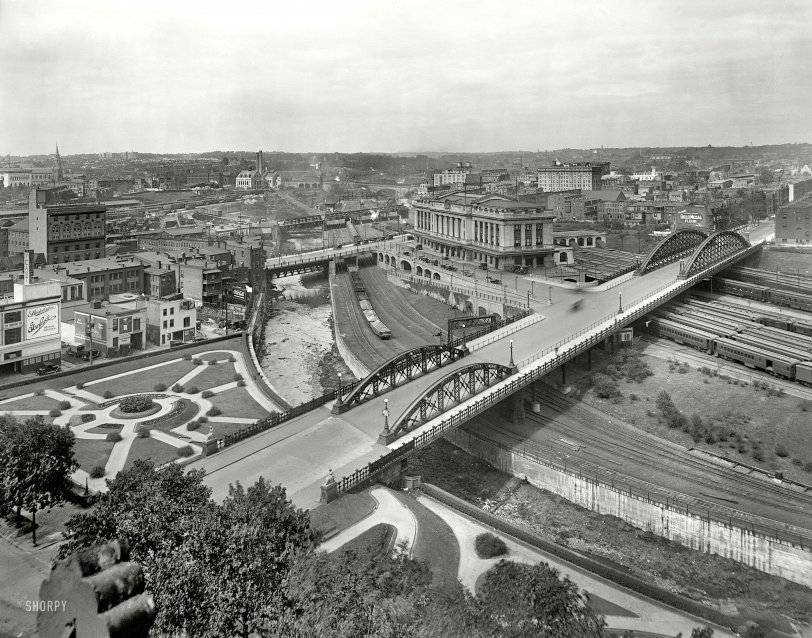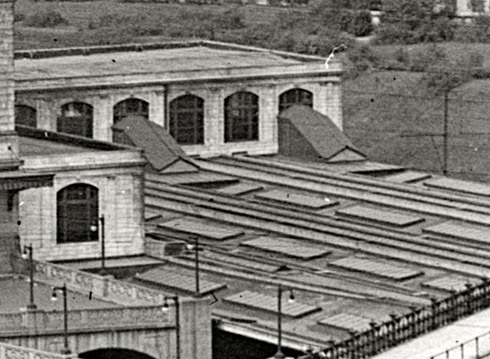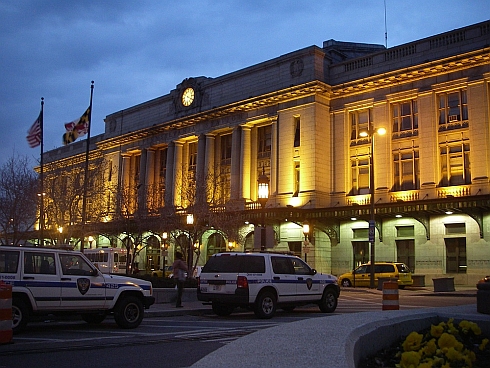


Framed or unframed, desk size to sofa size, printed by us in Arizona and Alabama since 2007. Explore now.
Shorpy is funded by you. Patreon contributors get an ad-free experience.
Learn more.

- Baldwin 62303
- Baldwin VO-1000
- Cold
- No expense spared
- Tough Guys
- Lost in Toyland
- And without gloves
- If I were a blindfolded time traveler
- Smoke Consumer Also Cooks
- Oh that stove!
- Possibly still there?
- What?!?
- $100 Reward
- Freeze Frame
- Texas Flyer wanted
- Just a Year Too Soon
- WWII -- Replacing men with women at the railroad crossing.
- Yes, Icing
- You kids drive me nuts!
- NOT An Easy Job
- I wonder
- Just add window boxes
- Icing Platform?
- Indiana Harbor Belt abides
- Freezing haze
- Corrections (for those who care)
- C&NW at Nelson
- Fallen Flags
- A dangerous job made worse
- Water Stop
Print Emporium
Bustling Baltimore: 1917

Baltimore, Maryland, circa 1917. "Union Station showing Charles Street and Jones Falls." 8x10 inch glass negative, Detroit Publishing Company. View full size.
Corpus Christi Church and MICA
The tall pointy steeple in the upper left corner is Corpus Christi Church, and the white building to its left is the Maryland Institute College of Art where I went to college.
Looks like the early 1920’s
by the look of some of the cars
Morgan Millwork Co.
Morgan Millwork Co. was the eastern warehouse and showroom for the Morgan Sash & Door Company.
Architectural Record, 1910.Correct Craftsmen Style
Morgan Doors are noted for correctness and originality of design and finish. Their construction is guaranteed to be absolutely faultless. Morgan Doors add wonderfully to the permanent value, comfort, beauty and satisfaction of the house.
Morgan Doors are light, remarkably strong, and built of several layers of wood with grain running in opposite directions. Shrinking, warping or swelling is impossible. Veneered in all varieties of hard wood — Birch, plain or quarter-sawed red or white Oak, brown Ash, Mahogany, etc. Any style of architecture. Very best for Residences, Apartments, Offices, Bungalows or any building.
Each Morgan Door is stamped "Morgan" which guarantees highest quality, style, durability and satisfaction. You can have Morgan Doors if you specify and insist.
The National Builder, 1915.Morgan Sash & Door Company
Department A-22, Chicago
Factory: Morgan Co., Oshkosh, Wis. Eastern Warehouse and Display, Morgan Millwork Co., Baltimore. Displays: 6 East 19th St., New York; 309 Palmer Bldg., Detroit; Building Exhibit, Insurance Exchange, Chicago.
What Is Their Purpose?
Toward the right side of the photo there are some rectangular blocks on top of a building behind the Union Station building. Two of them are up against the windows in a sort of wavy manner. They look sort of like warped mini-roofs. What is their purpose and why are they wavy and slanted as opposed to flat like the other ones?
[Wavy things: roofs over stairways. Flat things: skylights. - Dave]

Another Inspiration
I wish I was a kid again. What a grand sight this would be in H.O. Scale!
Railway Express & Oysters
In the mid '60s I worked for Railway Express and each weekday night we would make a run from our depot on Calvert & Centre to Penn Station. The usual cargo was mainly express packages and barrels of oysters and boxes of soft shelled crabs fresh from Crisfield on the Chesapeake Bay headed to Philadelphia and New York.
We would drive down that ramp to train track level and transfer the barrels to those high-wheeled station carts, which were pulled by a small mule (automotive variety).
As the train entered the station we would drive alongside as it came to a stop so our carts were lined up with the messenger car. We had ten frantic minutes of rolling the barrels into the car until the train pulled out. Thankfully we never hit a passenger or dropped a barrel onto the tracks.
That was always the best part of our night since after that we would take our time getting back to the depot so we got there just about time to punch out and head down Calvert Street to Susie's for an after work beer.
So if sometime you stopped in an Oyster Bar in Philly or New York and had either some soft shell crabs or oysters and remarked about the freshness of the same it might have been me who got them there for you.
Bawlmer -- where do I start?
You'll need the hi-def version to follow me here.
The freight yard across the top of the photo is the Northern Central Railway, and since 1912, the Pennsylvania RR Bolton Freight Station. My great grandfather was likely working there this day, as he would until Bolton Street was closed. Just off photo to the distant left is B&O's Mount Royal Station, the tracks of which are below grade behind the PRR yard.
The Studebaker/Garford shop was known as Zell Motor Car Company; my grandmother's brother-in-law was a highly regarded mechanic there for many years. The prominent arch-windowed building behind it on Charles Street is now part of University of Baltimore, where I attended classes for a time.
The beautiful massive stone structure in the distance with two stacks was a water pumping station, removed for I-83 construction in the 1960s.
Directly in front of that building is North Avenue "NA" Tower; it's dark because it is painted in B&O's red color. NA Tower protected the crossing between the two track line seen crossing Jones Falls, and the B&O main line, which isn't visible here. Note locomotives on both sides of NA tower.
The water course in the middle is Jones Falls (the name being a peculiarity of the region; instead of Creek or Run, sometimes a channel was called a Falls).
The most distant bridge is North Avenue Viaduct, built in the 1890s and still in use. Close behind the viaduct is B&O's bridge over the Falls, not visible here. At the right end of the viaduct, above the Morgan Millwork sign, can be seen the B&O mainline to Philadelphia and where I labored four decades.
Finally, great big Union Station isn't the only downtown passenger terminal in view. Just left of Morgan Millwork and above the City Ice sign is the peaked roof of the Maryland and Pennsylvania (Ma & Pa) RR's Oak Street Station.
Beautiful shot. Thanks, Dave!
Still vibrant on the eve of WWI
Baltimore was my childhood home. This view, dated 1917, shows a Baltimore that was still a vibrant city. Note the tenement homes, in good shape, interspersed with a variety of industry and transportation. Home to the country's first railroad, Baltimore was the second largest port on the East Coast.
The streets are clean and there are landscaped areas to be enjoyed by the residents -- a bit of elbow room to make life bearable. Thirteen years earlier, downtown Balto had suffered a major fire.
The Baltimore of today is but a shadow of its former self, having suffered substantial economic and social decay.
This photo evokes a sad nostalgia of a bygone era.
It's Penn Station now
and still in full daily use, including as a main stop on the Amtrak high-speed Northeast Corridor between Washington and Boston.

Don't forget the ice!
Sign behind and to the left of Union Station.
Flour, Yeast, Studebakers and Coke
What else can you possibly want?
























On Shorpy:
Today’s Top 5